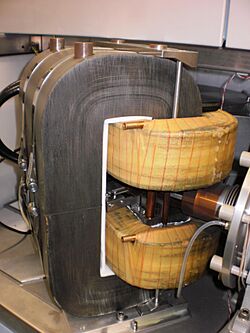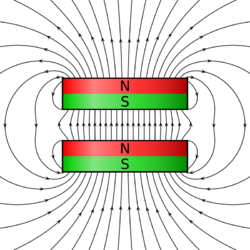Dipole magnet facts for kids
Imagine a magnet with two distinct ends, like a toy bar magnet. One end is the north pole, and the other is the south pole. This is what we call a dipole magnet. It's the most basic type of magnet you can find.
The invisible lines of force, called magnetic field lines, always leave the north pole. They curve around and enter the south pole. Inside the magnet, these lines complete their journey, forming a continuous loop. A common example of a dipole magnet is a simple bar magnet.
Contents
Dipole Magnets in Particle Accelerators
Particle accelerators are huge machines. They speed up tiny particles, like protons, to nearly the speed of light. To guide these super-fast particles, scientists use powerful magnets. One key type is the dipole magnet.
These special electromagnets create a steady magnetic field. This field acts like an invisible wall. It pushes the charged particles, making them move in a curved path. Think of it like steering a race car around a track.
How Magnets Bend Particles
When a charged particle enters a dipole magnet's field, it starts to curve. The particle moves in a circle or a spiral shape. This happens in a plane that is straight across from the magnetic field. The direction of the curve depends on the particle's charge.
By placing several dipole magnets in a row, scientists can bend the particle beam a lot. This is how particles travel in big circles inside accelerators. This bending is super important for making particles collide or for creating special light.
The force that bends these particles is called the Lorentz force. It describes how electric and magnetic fields push on charged particles. In accelerators, the magnetic field does most of the work. It makes the particles change direction without slowing them down.
The Power of Magnetic Fields
As particles gain more energy, they move even faster. Bending these super-energetic particles becomes harder. They need a stronger magnetic push to stay on track. This means the dipole magnets must create very powerful magnetic fields.
There's a limit to how strong these fields can be. Because of this, very high-energy accelerators must be huge. They need many dipole magnets to gently steer the particles. For example, the Large Hadron Collider (LHC) is the world's largest accelerator. It uses 1,232 main dipole magnets. Each one weighs about 35 metric tons, which is like 35 small cars!
Keeping the Beam Steady
The magnets in accelerators need very precise control. They are powered by special devices called power supplies. These supplies act like super-accurate electricity generators. They make sure the electric current flowing through the magnets is extremely stable.
Why is this important? Because the strength of the magnetic field depends on the current. If the current changes even a tiny bit, the particle beam could go off course. Scientists need the magnetic field to be steady for many hours. This keeps the particles on their perfect path. It also ensures the experiments work correctly.
Other Cool Uses for Dipole Magnets
Dipole magnets aren't just for giant particle accelerators. They have many other important jobs!
One use is in mass spectrometry. This is a science tool that measures the mass of tiny particles. Dipole magnets help separate particles based on their mass. This allows scientists to identify different substances.
They are also used in particle physics experiments. Here, they help measure how fast particles are moving. This is called measuring their momentum.
You might have even seen dipole magnets in old televisions! Traditional TVs used a cathode-ray tube. This tube was like a mini particle accelerator. It shot a beam of electrons at the screen. Special magnets, called deflecting coils, steered this electron beam. They moved the single bright spot all over the screen very quickly. This created the pictures you saw.
See Also
- Accelerator physics
- Beam line
- Cyclotron
- Electromagnetism
- Linear particle accelerator
- Particle accelerator
- Quadrupole magnet
- Sextupole magnet
- Multipole magnet
- Storage ring





